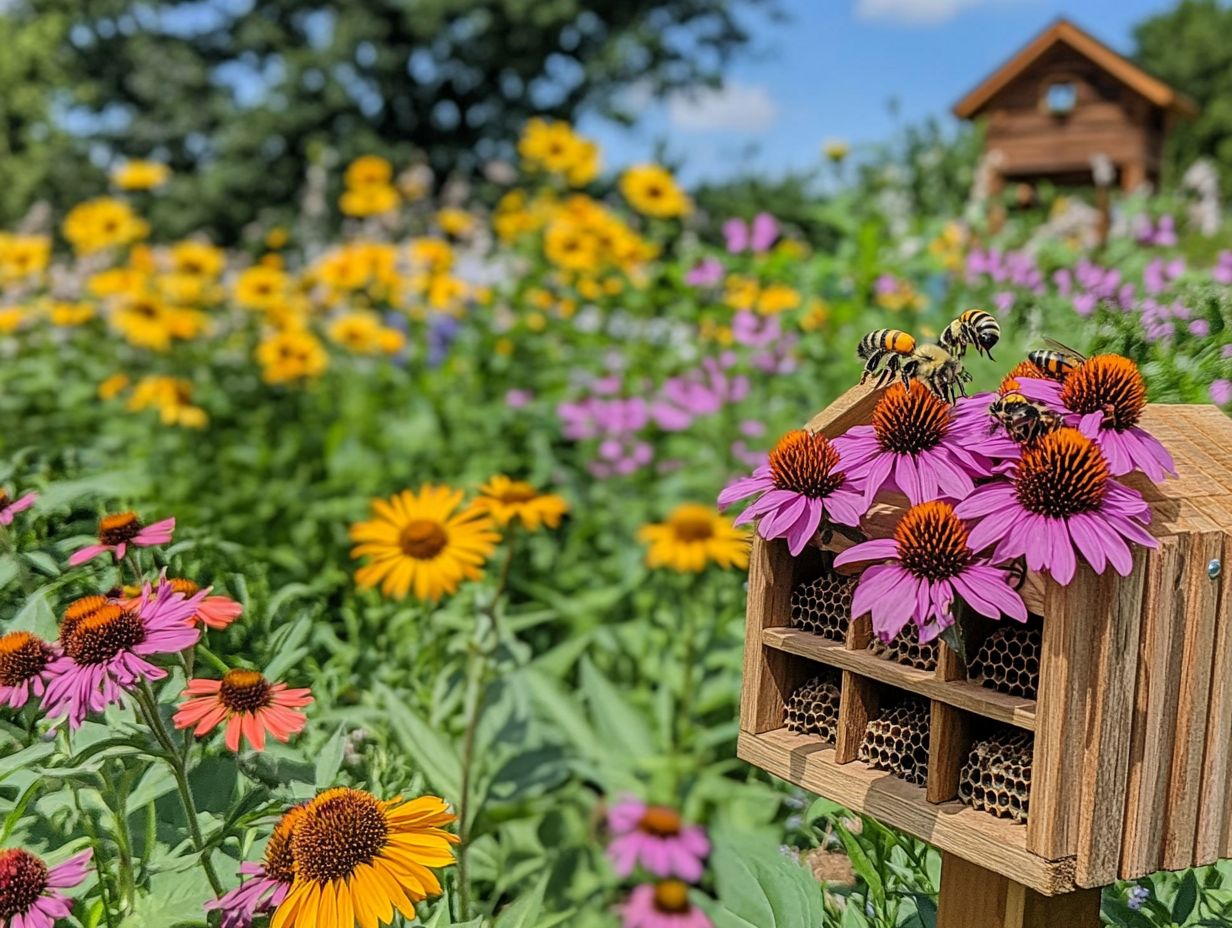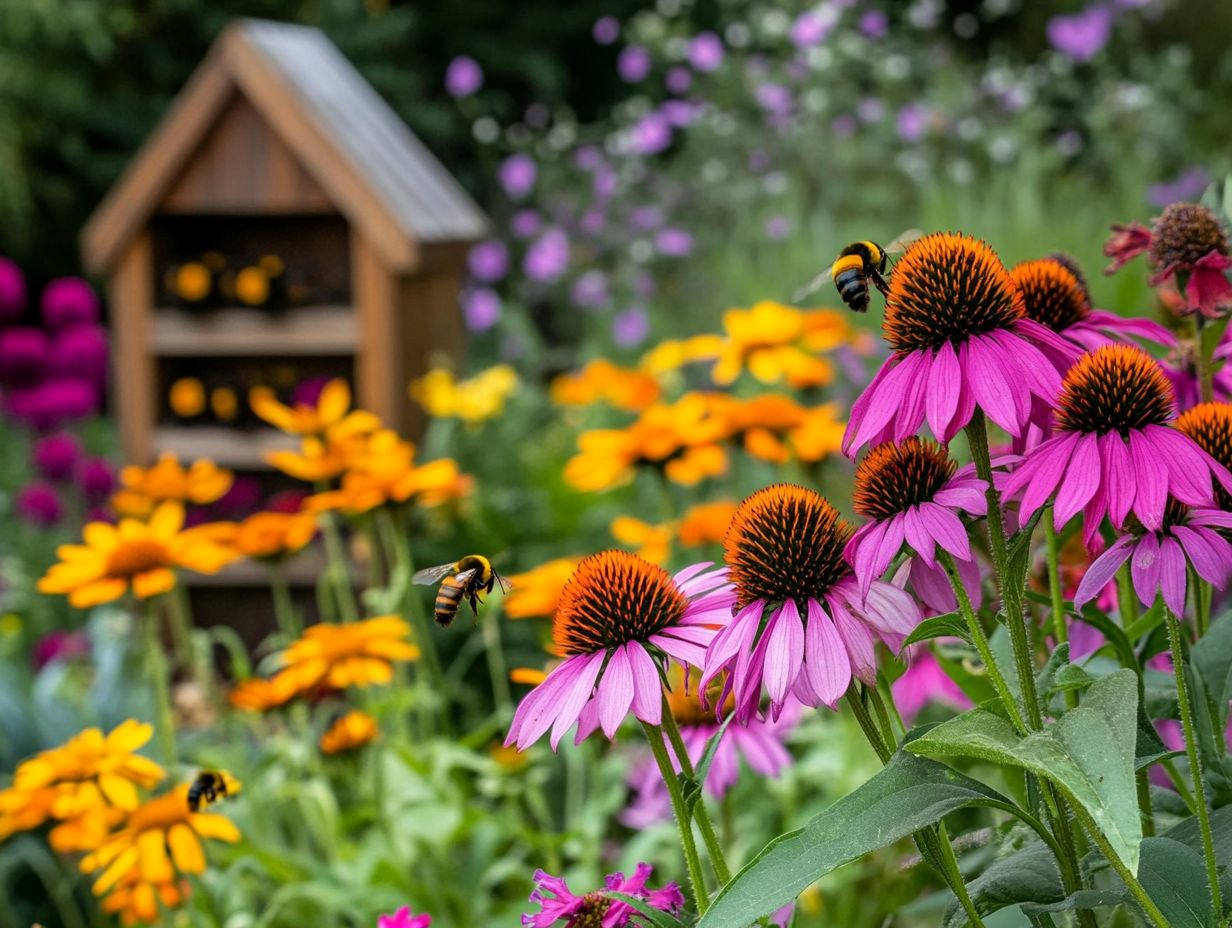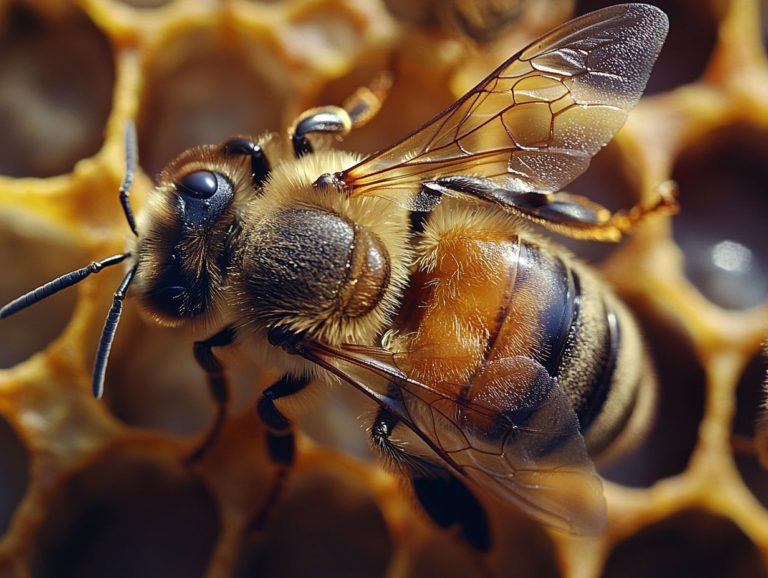5 Ways to Attract Native Bees to Your Garden
Native bees are essential to the health of our ecosystems, particularly within the gardens you cultivate. They pollinate plants and enhance biodiversity. These bees, including species identified by the Oregon Bee Project and mapped by the Oregon Bee Atlas, play a critical role in our environment.
If you aim to create a flourishing garden that entices these invaluable insects, you are certainly in the right place. This article will guide you through five effective strategies to welcome native bees into your outdoor sanctuary, from selecting native flowers to offering suitable nesting sites and considering garden conditions.
It will also shed light on the significance of these bees, dispel common misconceptions, and provide insights on how to support their populations. Dive in and see how you can transform your garden into a buzzing paradise for native bees!
Contents
- Key Takeaways:
- 1. Plant Native Flowers
- 2. Provide a Variety of Blooming Plants
- 3. Create a Water Source
- 4. Avoid Pesticides and Chemicals
- 5. Provide Nesting Sites
- Why Are Native Bees Important for Gardens?
- Frequently Asked Questions
- What are native bees and why should I attract them to my garden?
- What are the best ways to attract native bees to my garden?
- Can I attract native bees to my garden even if I live in an urban area?
- Are there any specific plants or flowers that are particularly attractive to native bees?
- How long does it take for native bees to start visiting my garden?
- Are there any other benefits to attracting native bees to my garden?
Key Takeaways:

- Choose native flowers to attract bees to your garden. They are adapted to the local climate and provide the right type of pollen and nectar for the bees.
- Include a variety of blooming plants throughout the year to provide a continuous food source for native bees. This will also attract different types of bees, ensuring a diverse and healthy ecosystem, particularly in urban gardens where floral diversity is crucial.
- Provide a water source by adding a shallow dish filled with rocks and water to your garden. This will also give bees a place to rest and cool off.
1. Plant Native Flowers
Planting native flowers in your garden is not just a beautiful enhancement; it’s essential for supporting native bees. These bees play a pivotal role in pollination and ecosystem health. In Oregon, native plants have adapted seamlessly to the local environment, making them the perfect choice for thriving gardens. Gail Langellotto from OSU Extension emphasizes the importance of native plants for bee conservation.
By incorporating a variety of native flowering plants, you can cultivate a sustainable garden that meets the habitat needs of diverse bee species. This will provide vital nectar a sweet substance that serves as food for bees and pollen sources throughout the blooming season.
For example, the Oregon state flower, the Oregon grape, bursts into bloom in early spring. This offers a crucial food source for local bee populations emerging from their winter slumber. Similarly, flowers like lupines and coneflowers come alive in mid-summer, ensuring bees have access to nectar when other blooms might have bid farewell for the season.
By creating a pollinator habitat with these native species, you not only elevate the beauty of your landscape but also enhance biodiversity in your area. This commitment contributes to a larger ecological balance. Robust bee populations are essential for food production and the overall health of ecosystems. By being intentional about blooming seasons and your selection of plants, you can significantly support these invaluable pollinators.
2. Provide a Variety of Blooming Plants
Providing a variety of blooming plants is essential for cultivating a vibrant ecological environment in your Oregon garden. This diversity ensures that native bees and other insect pollinators have plentiful resources throughout the seasons. Thoughtfully selecting flowering plants that bloom at different times will create a continuous source of nectar and pollen, which is crucial for the survival of bee species.
Consider early bloomers like crocus and snowdrop, which herald the arrival of spring. Mid-spring flowers such as lupine and penstemon attract a wider array of bee species, enriching the pollinator population in your garden. And we mustn’t forget about late bloomers like asters and goldenrod. They extend the foraging period into the fall, allowing hard-working pollinators to gather resources before winter sets in.
By incorporating these plants into your garden, you actively support a thriving ecosystem, enhance biodiversity, and promote resilience in your local environment. Your efforts will benefit the bees and create a beautiful and dynamic space that flourishes with life.
Start today and watch your garden thrive!
3. Create a Water Source
A water source enriches your garden and supports pollinators, particularly the native bees that thrive in Oregon gardens. A small birdbath or a shallow dish filled with water can serve as an essential hydration point for various bee species. This is especially important during dry spells when natural water sources become scarce. By incorporating this thoughtful feature, you bolster the health of local pollinators and protect local wildlife.
Beyond birdbaths, explore other water options, such as small ponds or rainwater collection systems. These additions attract a broader spectrum of beneficial insects, encouraging diverse wildlife and fostering a thriving ecosystem that includes butterflies and other pollinators!
To keep these features in top shape, maintain clean, algae-free water. Stagnant water can harbor harmful bacteria, so regularly refreshing the water and adding pebbles or stones for landing spots will ensure these areas remain inviting and safe for all visitors, supporting their crucial role in pollination.
4. Avoid Pesticides and Chemicals

Avoiding pesticides and harmful chemicals is essential for preserving the health and diversity of native bee species in your Oregon garden. These substances can wreak havoc on insect pollinators and the overall ecosystem. By minimizing your pesticide use, you protect native bees and contribute to habitat conservation, ensuring that local pollinators can thrive free from toxic chemicals. The OSU Extension offers guidelines for reducing pesticide use in favor of organic methods.
It’s important to understand that many conventional products can disrupt the delicate balance of nature, leading to declines in bees and other beneficial insects. Educating yourself about organic pest control methods, such as introducing beneficial predators or utilizing natural repellents, helps cultivate a more sustainable gardening approach.
Emphasizing the importance of planting diverse, native flora provides essential resources like nectar and pollen, which sustain healthy populations of these critical pollinators. By adopting these practices, you play a pivotal role in creating a thriving ecosystem that supports flourishing bee communities and enhances the beauty of your garden!
5. Provide Nesting Sites
Providing nesting sites is essential for supporting native bees, especially solitary species that depend on specific habitats to flourish in your Oregon garden. By adding features like bee hotels structures made from wood or other materials that provide safe nesting spots or preserving patches of bare soil, you effectively meet the habitat needs of these crucial pollinators! This plays a significant role in their conservation while enhancing your garden’s ecological balance. The Oregon Bee Project offers resources on creating ideal nesting conditions, including the use of diverse nesting materials.
Different bee species have distinct preferences, so embracing a diverse approach is key. For example, mason bees often gravitate towards drilled wood blocks or hollow stems, while leafcutter bees prefer materials like cardboard tubes. Constructing bee hotels with a variety of hole sizes will cater to multiple species and their unique nesting habits.
Leaving areas of bare ground is vital, as many ground-nesting bees, including certain bumblebee species, prefer sandy or loose soil for burrowing. Position these sites in sunny, sheltered locations away from heavy foot traffic to minimize threats from predators. A well-thought-out arrangement can significantly boost their chances of thriving in your garden.
Why Are Native Bees Important for Gardens?
Native bees play a critical role in your garden, helping to pollinate flowering plants that are crucial for both ecological health and agricultural productivity, particularly in Oregon.
These remarkable pollinators significantly enhance the floral diversity in your local garden, creating a robust ecosystem that supports not only plant life but also a variety of beneficial insects.
When you understand the vital environmental role of native bees, you ll be amazed at how valuable they are and can make informed decisions that foster the conservation essential for sustaining these insect populations. Resources from the American Museum of Natural History can further your knowledge on bee species and their roles.
The presence of native bees enhances fruit and seed production, allowing your plants to yield more and healthier crops. This natural pollination process elevates the quality of your produce and cultivates a thriving garden atmosphere.
The Oregon Department of Agriculture recognizes the importance of native bee species for local food production.
These industrious bees are key players in maintaining local ecosystems. They promote plant community resilience that supports diverse wildlife. The connection between pollinators and plant health is clear, highlighting the importance of safeguarding native bee populations in your preservation efforts.
Participation in local initiatives like Pollinator Week can raise awareness and support for bee conservation. Act now to protect these vital insects!
By protecting these essential pollinators, you ensure that your garden will continue to flourish and contribute meaningfully to the balance of nature.
What Are the Different Types of Native Bees?
Understanding the diversity of native bee species is crucial for creating effective conservation strategies. Resources like the Oregon Bee Atlas and the Oregon Bee Project can provide valuable insights into the different bee species found in Oregon gardens.
Oregon boasts over 500 distinct species of native bees, each with its own unique traits and nesting behaviors. This diversity makes it essential for you to familiarize yourself with the various native bee species in your area.
From solitary bees that prefer the ground to social bees that thrive within colonies, understanding these differences is key to effective species identification and creating the ideal habitat and resources in your garden.
Among the most common are bumblebees, easily recognized by their fuzzy bodies and their preference for nesting in abandoned rodent burrows or underground. There are also mason bees, which favor laying their eggs in pre-existing holes or tunnels, sealing their nests with mud or leaf material.
Identifying these bees typically involves paying attention to their size, color patterns, and nesting preferences. Recognizing their unique characteristics is vital not only for protecting local biodiversity but also for ensuring the pollination of plants crucial for thriving ecosystems and food production.
By creating suitable environments, such as providing a variety of pollen sources and proper nesting sites, you can significantly benefit these essential pollinators.
How Can Native Bees Benefit Your Garden?

Native bees are very important for the ecology of your garden. They bring a wealth of benefits such as enhanced pollination and increased yields of fruits and flowers.
These remarkable pollinators also contribute to the overall well-being of the ecosystem by helping more plants grow, creating a lively community of insects and plants.
By attracting native bees to your garden, you can really boost the productivity of crops like blueberries, squash, and tomatoes, which depend heavily on effective pollination for their optimal yields. For example, research has shown that blueberries thrive with visits from native bees, resulting in larger and sweeter berries.
This natural pollination method allows you to reduce your reliance on artificial techniques, creating a more harmonious environment where pollinators flourish alongside other beneficial creatures.
Native bees also play a crucial role in establishing a robust ecosystem that supports pest management. By encouraging a variety of pollinator-friendly plants, you ll attract a diverse range of insects that help maintain a healthier garden, ultimately reducing the need for chemical interventions.
What Are Some Common Mistakes When Trying to Attract Native Bees?
Many gardeners often overlook key considerations when trying to attract native bees. This oversight can significantly undermine their efforts to cultivate a flourishing pollinator habitat in Oregon gardens.
From selecting unsuitable plants to creating garden conditions that fail to meet the needs of these essential insects, recognizing these common pitfalls is vital for establishing a welcoming environment for native bees, as well as implementing 5 tips for attracting bees for honey production.
To genuinely support these crucial pollinators, you should avoid planting non-native species that lack the necessary nutrients or habitat structures. Excessive pesticide use can also be harmful, as these chemicals affect beneficial insects along with targeted pests. Instead of heavy chemical use, consider using natural methods to manage pests.
Another frequent misstep is failing to provide a diverse array of blooming plants throughout the growing season. This can lead to food shortages for native bees. By incorporating various native flowering plants that bloom at different times, you can ensure that bees have a consistent and plentiful food source, ultimately contributing to a healthier ecosystem.
What Are Some Other Ways to Support Native Bees?
Supporting native bees goes beyond your own garden; it involves engaging in community initiatives like the Oregon Bee Project, which emphasizes habitat conservation and research to protect these essential pollinators. Act now to support the Oregon Bee Project!
By participating in local conservation efforts and spreading the word about the significance of native bees, you can play a vital role in broader initiatives aimed at sustaining and enhancing bee populations in your community. Consider exploring 5 ways to encourage bee breeding to further support these important creatures.
You can advocate for pollinator-friendly spaces by encouraging local governments to establish and maintain habitats that welcome these important insects. Joining citizen science projects empowers you and your neighbors to monitor bee populations and their health, providing invaluable data for ongoing research.
Collaborating with local extension services not only allows you to share resources but also best practices, ensuring that everyone has access to the tools necessary for nurturing a thriving ecosystem. Remember, continuous education about the role of native bees is crucial. It fosters a culture of awareness and appreciation, engaging everyone in the shared journey toward sustainability.
How Can You Identify and Distinguish Native Bees from Other Insects?
Identifying and distinguishing native bees from other insects is essential for recognizing their role as vital pollinators in Oregon gardens. You can accomplish this through careful observation of their common features and behaviors. Native bees typically exhibit distinct body shapes, sizes, and colors that set them apart from other insect pollinators, like honeybees. This knowledge empowers you to make your garden friendly for bees.
Pay close attention to their behaviors. Many native bees tend to be solitary which means they live alone rather than in groups unlike honeybees, which thrive in large, social colonies. Observing their foraging habits can also provide valuable insights. For instance, native bees often have unique flower preferences and are more likely to visit a diverse array of plants throughout the day.
Dive into the amazing world of native bees! The Oregon Bee Atlas is an invaluable resource. It offers tools, guides, and opportunities for community engagement focused on bee identification and conservation efforts in local ecosystems.
Frequently Asked Questions
What are native bees and why should I attract them to my garden?
Native bees are bees that are naturally found in your region and have not been introduced from other areas. They are important pollinators for plants and play a crucial role in maintaining ecosystem balance. Attracting them to your garden can help increase pollination and promote a healthy, thriving garden.
What are the best ways to attract native bees to my garden?
- Plant native flowers and plants: Native bees are attracted to local plants, so planting a variety of these in your garden is a great way to draw them in.
- Create a bee-friendly habitat: Leave some bare ground for ground-nesting bees, provide shelter like a bee house or hollow stems for cavity-nesting bees, and avoid using pesticides.
- Use a diversity of colors and scents: Bees are drawn to different colors and scents, so planting a mix of flowers will appeal to various bee species.
- Provide a water source: Bees need water to survive, so having a shallow water source, such as a bird bath or small pond, can attract them.
- Have a continuous blooming season: Plant flowers that bloom at different times throughout the year to provide a steady food source for bees.
Can I attract native bees to my garden even if I live in an urban area?
Yes! You can still attract native bees to your garden in urban areas. Consider using container gardens or window boxes to grow native plants and flowers, and provide a water source and nesting areas for bees.
Are there any specific plants or flowers that are particularly attractive to native bees?
Yes, certain plants and flowers are more attractive to native bees. Some examples include sunflowers, lavender, black-eyed susans, and milkweed. Research the native plants in your area to determine which ones are best for attracting bees.
How long does it take for native bees to start visiting my garden?
This can vary depending on the location and readiness of your garden, but typically, it can take a few weeks to a few months for native bees to start visiting after you have implemented bee-friendly practices. Be patient and continue to provide a welcoming habitat for them.
Are there any other benefits to attracting native bees to my garden?
Yes, in addition to pollinating your garden, native bees can act as natural pest controllers by preying on harmful insects. They also contribute to the overall health and diversity of your garden ecosystem. Attracting native bees can be a rewarding and educational experience for you and your family.
Start planting these flowers now and watch your garden buzz with life!







